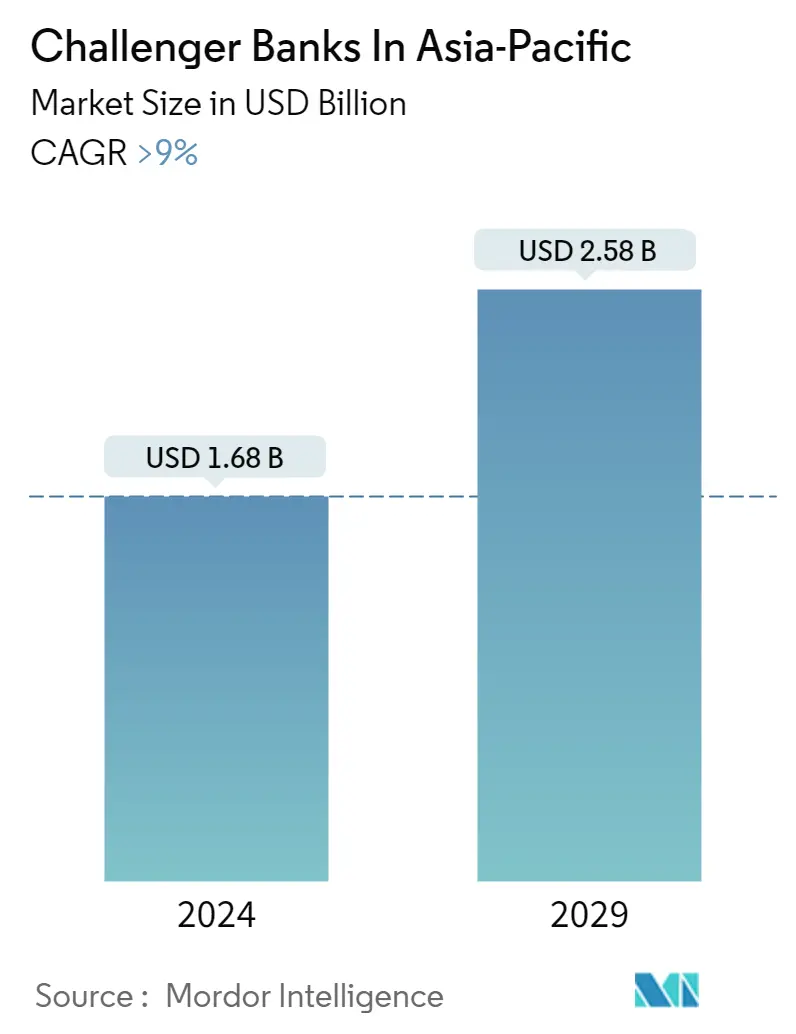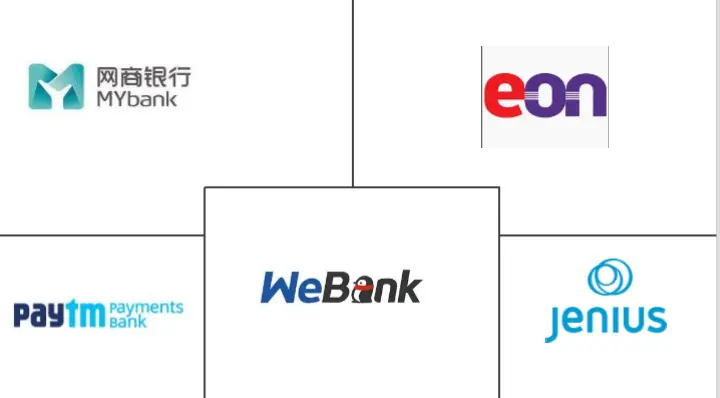Market Size of Challenger Banks In Asia-Pacific

| Study Period | 2020 - 2029 |
| Base Year For Estimation | 2023 |
| Forecast Data Period | 2024 - 2029 |
| Market Size (2024) | USD 1.68 Billion |
| Market Size (2029) | USD 2.58 Billion |
| CAGR (2024 - 2029) | 9.00 % |
| Market Concentration | Medium |
Major Players
*Disclaimer: Major Players sorted in no particular order |
APAC Challenger Banks Market Analysis
The Challenger Banks In Asia-Pacific Market size is estimated at USD 1.68 billion in 2024, and is expected to reach USD 2.58 billion by 2029, growing at a CAGR of greater than 9% during the forecast period (2024-2029).
Even though the onset of the pandemic enhanced the need for rapid tech-led transformation for the banks and financial services players, they are still being used by many people. Digital banks, also known as neobanks, challenger banks, or virtual banks, all have in common are they often started with no physical branches and leveraged technology to differentiate their offerings in the banking sphere.The virtual banks are helping a lot of people in the Asia - Pacific region to have a smooth banking experience without visiting the bank. Asia’s digital banking scene has seen rapid growth in recent years and is set to continue its growth in the months to come.
63% of banking customers in Asia-Pacific (APAC) are likely to use digital banking services offered by neobanks and challenger banks by 2025, highlighting the urgency for banks to innovate. Also many commercial places such as restauarants are now looking towards Challengers Banks as they are flexible enough, without having a need to visit any physical bank. More than 35 neobanks or challengers across APAC are built on agile innovative best practices — way ahead of incumbents in terms of flexibility, self-service capabilities, customer needs, and personalization. Consequently, with the emergence of new players and further digital disruption in the industry, 38% of traditional banks’ revenues are at risk by 2025.
Additionally, a recent report has revealed that Asian Pacific countries are becoming increasingly interested in the digital banking space, with India being home to twenty percent of the global number of digital challenger banks. The report has noted that the Indian Subcontinent has witnessed the emergence of a three-pronged attack in the space, consisting of banks' own challengers such as Bank 811 and Bank Digibank, as well as new challengers such as Network, Fi Money and FamPay, as well as Open and Jupiter, as well as ecosystem players Paytm, Razorpay.
APAC Challenger Banks Industry Segmentation
The challenger banks are set to provide a different banking experience to the customers, different from the traditional banks. A complete background analysis of the Challenger Banks Market, market overview, market size estimation for key segments, emerging trends in the market, market dynamics, and key company profiles are covered in the report. The Challenger Banks Market in Asia-Pacific is segmentedby services offered, end-user type, and by country. By services offered, the market is segmented as Payments,Savings Products, Current Account, Consumers Credits, Loans and Others. By end-user type, the market is segmented as Business Segment and Personal Segment. By Country, the market is segmented as China, South Korea, Australia, Hong Kong, India, Indonesia, Philippines, Malaysia, Singapore and Rest of Asia-Pacific. The market size and forecasts are provided in terms of value (USD) for all the above segments.
| By Service Type | |
| Payments | |
| Savings Products | |
| Current Account | |
| Consumer Credit | |
| Loans | |
| Others |
| By End-User Type | |
| Business Segment | |
| Personal Segment |
| By Country | |
| China | |
| South Korea | |
| Australia | |
| Hong Kong | |
| India | |
| Indonesia | |
| Philippines | |
| Malaysia | |
| Singapore | |
| Rest of Asia-Pacific |
Challenger Banks In Asia-Pacific Size Summary
The challenger banks market in the Asia-Pacific region is experiencing significant growth, driven by the increasing adoption of digital banking solutions. These banks, often referred to as neobanks or virtual banks, have gained popularity due to their tech-driven approach and absence of physical branches, offering customers a seamless banking experience. The region's digital banking landscape has expanded rapidly, with a substantial portion of the population expected to utilize these services in the coming years. The rise of challenger banks is particularly notable in countries like India, where a diverse range of digital banking players, including both traditional banks' challengers and new entrants, are reshaping the financial services sector. The market's growth is further fueled by factors such as high mobile penetration, a large unbanked population, and a burgeoning middle class, particularly in emerging markets within the region.
The market is moderately fragmented, with major players like WeBank, MY Bank, EON Bank PH, Paytm Payments Bank, and Jenius Bank holding significant market shares. These banks have attracted considerable investor interest, evidenced by a surge in equity financing and mergers and acquisitions. The report highlights the successful strategies of banks like Kakao Bank and Paytm Payments Bank, which have rapidly expanded their customer bases and service offerings. Technological advancements, regulatory changes, and strategic partnerships are expected to drive further growth in the sector. Innovations such as Paytm's alternate ID-based guest checkout solution and portable payment devices exemplify the ongoing technological evolution within the market, positioning challenger banks as key players in the future of banking in the Asia-Pacific region.
Challenger Banks In Asia-Pacific Market Size - Table of Contents
-
1. MARKET DYNAMICS AND INSIGHTS
-
1.1 Market Overview
-
1.2 Market Drivers
-
1.2.1 Increase in Internet Penetration is Driving the Market
-
-
1.3 Market Restraints
-
1.3.1 Government Policies Regarding the Challengers Bank Market
-
-
1.4 Market Opportunities
-
1.4.1 Use of Advanced Technology by the Market Players
-
-
1.5 Insights on Impact of Technology and Innovation in Operation in Challengers Banking System
-
1.6 Industry Attractiveness - Porter's Five Force Analysis
-
1.6.1 Threat of New Entrants
-
1.6.2 Bargaining Power of Buyers/Consumers
-
1.6.3 Bargaining Power of Suppliers
-
1.6.4 Threat of Substitute Products
-
1.6.5 Intensity of Competitive Rivalry
-
-
1.7 Impact of COVID-19 on the Market
-
-
2. MARKET SEGMENTATION
-
2.1 By Service Type
-
2.1.1 Payments
-
2.1.2 Savings Products
-
2.1.3 Current Account
-
2.1.4 Consumer Credit
-
2.1.5 Loans
-
2.1.6 Others
-
-
2.2 By End-User Type
-
2.2.1 Business Segment
-
2.2.2 Personal Segment
-
-
2.3 By Country
-
2.3.1 China
-
2.3.2 South Korea
-
2.3.3 Australia
-
2.3.4 Hong Kong
-
2.3.5 India
-
2.3.6 Indonesia
-
2.3.7 Philippines
-
2.3.8 Malaysia
-
2.3.9 Singapore
-
2.3.10 Rest of Asia-Pacific
-
-
Challenger Banks In Asia-Pacific Market Size FAQs
How big is the Challenger Banks In Asia-Pacific Market?
The Challenger Banks In Asia-Pacific Market size is expected to reach USD 1.68 billion in 2024 and grow at a CAGR of greater than 9% to reach USD 2.58 billion by 2029.
What is the current Challenger Banks In Asia-Pacific Market size?
In 2024, the Challenger Banks In Asia-Pacific Market size is expected to reach USD 1.68 billion.

